Input interpretation

NH_3 ammonia + O_2 oxygen ⟶ NO nitric oxide + H_2O water
Balanced equation
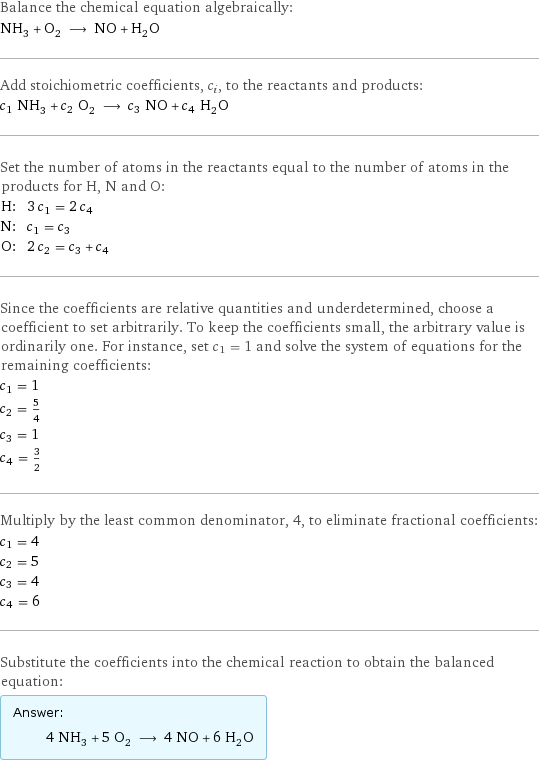
Balance the chemical equation algebraically: NH_3 + O_2 ⟶ NO + H_2O Add stoichiometric coefficients, c_i, to the reactants and products: c_1 NH_3 + c_2 O_2 ⟶ c_3 NO + c_4 H_2O Set the number of atoms in the reactants equal to the number of atoms in the products for H, N and O: H: | 3 c_1 = 2 c_4 N: | c_1 = c_3 O: | 2 c_2 = c_3 + c_4 Since the coefficients are relative quantities and underdetermined, choose a coefficient to set arbitrarily. To keep the coefficients small, the arbitrary value is ordinarily one. For instance, set c_1 = 1 and solve the system of equations for the remaining coefficients: c_1 = 1 c_2 = 5/4 c_3 = 1 c_4 = 3/2 Multiply by the least common denominator, 4, to eliminate fractional coefficients: c_1 = 4 c_2 = 5 c_3 = 4 c_4 = 6 Substitute the coefficients into the chemical reaction to obtain the balanced equation: Answer: | | 4 NH_3 + 5 O_2 ⟶ 4 NO + 6 H_2O
Structures

+ ⟶ +
Names

ammonia + oxygen ⟶ nitric oxide + water
Reaction thermodynamics
Enthalpy
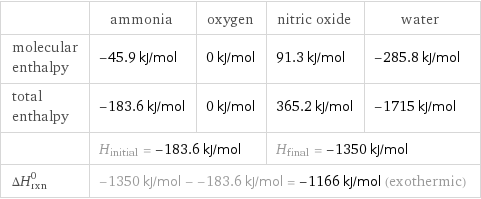
| ammonia | oxygen | nitric oxide | water molecular enthalpy | -45.9 kJ/mol | 0 kJ/mol | 91.3 kJ/mol | -285.8 kJ/mol total enthalpy | -183.6 kJ/mol | 0 kJ/mol | 365.2 kJ/mol | -1715 kJ/mol | H_initial = -183.6 kJ/mol | | H_final = -1350 kJ/mol | ΔH_rxn^0 | -1350 kJ/mol - -183.6 kJ/mol = -1166 kJ/mol (exothermic) | | |
Gibbs free energy
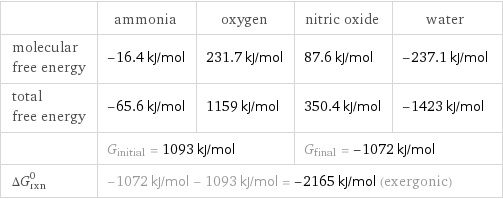
| ammonia | oxygen | nitric oxide | water molecular free energy | -16.4 kJ/mol | 231.7 kJ/mol | 87.6 kJ/mol | -237.1 kJ/mol total free energy | -65.6 kJ/mol | 1159 kJ/mol | 350.4 kJ/mol | -1423 kJ/mol | G_initial = 1093 kJ/mol | | G_final = -1072 kJ/mol | ΔG_rxn^0 | -1072 kJ/mol - 1093 kJ/mol = -2165 kJ/mol (exergonic) | | |
Entropy
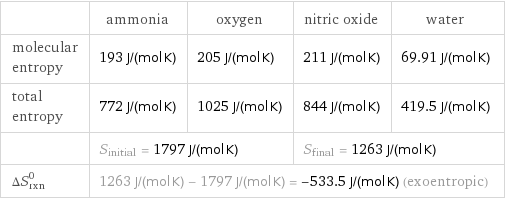
| ammonia | oxygen | nitric oxide | water molecular entropy | 193 J/(mol K) | 205 J/(mol K) | 211 J/(mol K) | 69.91 J/(mol K) total entropy | 772 J/(mol K) | 1025 J/(mol K) | 844 J/(mol K) | 419.5 J/(mol K) | S_initial = 1797 J/(mol K) | | S_final = 1263 J/(mol K) | ΔS_rxn^0 | 1263 J/(mol K) - 1797 J/(mol K) = -533.5 J/(mol K) (exoentropic) | | |
Equilibrium constant
![Construct the equilibrium constant, K, expression for: NH_3 + O_2 ⟶ NO + H_2O Plan: • Balance the chemical equation. • Determine the stoichiometric numbers. • Assemble the activity expression for each chemical species. • Use the activity expressions to build the equilibrium constant expression. Write the balanced chemical equation: 4 NH_3 + 5 O_2 ⟶ 4 NO + 6 H_2O Assign stoichiometric numbers, ν_i, using the stoichiometric coefficients, c_i, from the balanced chemical equation in the following manner: ν_i = -c_i for reactants and ν_i = c_i for products: chemical species | c_i | ν_i NH_3 | 4 | -4 O_2 | 5 | -5 NO | 4 | 4 H_2O | 6 | 6 Assemble the activity expressions accounting for the state of matter and ν_i: chemical species | c_i | ν_i | activity expression NH_3 | 4 | -4 | ([NH3])^(-4) O_2 | 5 | -5 | ([O2])^(-5) NO | 4 | 4 | ([NO])^4 H_2O | 6 | 6 | ([H2O])^6 The equilibrium constant symbol in the concentration basis is: K_c Mulitply the activity expressions to arrive at the K_c expression: Answer: | | K_c = ([NH3])^(-4) ([O2])^(-5) ([NO])^4 ([H2O])^6 = (([NO])^4 ([H2O])^6)/(([NH3])^4 ([O2])^5)](../image_source/27d25b4f771a2fb78f51338bfcf38a37.png)
Construct the equilibrium constant, K, expression for: NH_3 + O_2 ⟶ NO + H_2O Plan: • Balance the chemical equation. • Determine the stoichiometric numbers. • Assemble the activity expression for each chemical species. • Use the activity expressions to build the equilibrium constant expression. Write the balanced chemical equation: 4 NH_3 + 5 O_2 ⟶ 4 NO + 6 H_2O Assign stoichiometric numbers, ν_i, using the stoichiometric coefficients, c_i, from the balanced chemical equation in the following manner: ν_i = -c_i for reactants and ν_i = c_i for products: chemical species | c_i | ν_i NH_3 | 4 | -4 O_2 | 5 | -5 NO | 4 | 4 H_2O | 6 | 6 Assemble the activity expressions accounting for the state of matter and ν_i: chemical species | c_i | ν_i | activity expression NH_3 | 4 | -4 | ([NH3])^(-4) O_2 | 5 | -5 | ([O2])^(-5) NO | 4 | 4 | ([NO])^4 H_2O | 6 | 6 | ([H2O])^6 The equilibrium constant symbol in the concentration basis is: K_c Mulitply the activity expressions to arrive at the K_c expression: Answer: | | K_c = ([NH3])^(-4) ([O2])^(-5) ([NO])^4 ([H2O])^6 = (([NO])^4 ([H2O])^6)/(([NH3])^4 ([O2])^5)
Rate of reaction
![Construct the rate of reaction expression for: NH_3 + O_2 ⟶ NO + H_2O Plan: • Balance the chemical equation. • Determine the stoichiometric numbers. • Assemble the rate term for each chemical species. • Write the rate of reaction expression. Write the balanced chemical equation: 4 NH_3 + 5 O_2 ⟶ 4 NO + 6 H_2O Assign stoichiometric numbers, ν_i, using the stoichiometric coefficients, c_i, from the balanced chemical equation in the following manner: ν_i = -c_i for reactants and ν_i = c_i for products: chemical species | c_i | ν_i NH_3 | 4 | -4 O_2 | 5 | -5 NO | 4 | 4 H_2O | 6 | 6 The rate term for each chemical species, B_i, is 1/ν_i(Δ[B_i])/(Δt) where [B_i] is the amount concentration and t is time: chemical species | c_i | ν_i | rate term NH_3 | 4 | -4 | -1/4 (Δ[NH3])/(Δt) O_2 | 5 | -5 | -1/5 (Δ[O2])/(Δt) NO | 4 | 4 | 1/4 (Δ[NO])/(Δt) H_2O | 6 | 6 | 1/6 (Δ[H2O])/(Δt) (for infinitesimal rate of change, replace Δ with d) Set the rate terms equal to each other to arrive at the rate expression: Answer: | | rate = -1/4 (Δ[NH3])/(Δt) = -1/5 (Δ[O2])/(Δt) = 1/4 (Δ[NO])/(Δt) = 1/6 (Δ[H2O])/(Δt) (assuming constant volume and no accumulation of intermediates or side products)](../image_source/73bf1cd09dc1eaa03832e40588a9cf5f.png)
Construct the rate of reaction expression for: NH_3 + O_2 ⟶ NO + H_2O Plan: • Balance the chemical equation. • Determine the stoichiometric numbers. • Assemble the rate term for each chemical species. • Write the rate of reaction expression. Write the balanced chemical equation: 4 NH_3 + 5 O_2 ⟶ 4 NO + 6 H_2O Assign stoichiometric numbers, ν_i, using the stoichiometric coefficients, c_i, from the balanced chemical equation in the following manner: ν_i = -c_i for reactants and ν_i = c_i for products: chemical species | c_i | ν_i NH_3 | 4 | -4 O_2 | 5 | -5 NO | 4 | 4 H_2O | 6 | 6 The rate term for each chemical species, B_i, is 1/ν_i(Δ[B_i])/(Δt) where [B_i] is the amount concentration and t is time: chemical species | c_i | ν_i | rate term NH_3 | 4 | -4 | -1/4 (Δ[NH3])/(Δt) O_2 | 5 | -5 | -1/5 (Δ[O2])/(Δt) NO | 4 | 4 | 1/4 (Δ[NO])/(Δt) H_2O | 6 | 6 | 1/6 (Δ[H2O])/(Δt) (for infinitesimal rate of change, replace Δ with d) Set the rate terms equal to each other to arrive at the rate expression: Answer: | | rate = -1/4 (Δ[NH3])/(Δt) = -1/5 (Δ[O2])/(Δt) = 1/4 (Δ[NO])/(Δt) = 1/6 (Δ[H2O])/(Δt) (assuming constant volume and no accumulation of intermediates or side products)
Chemical names and formulas
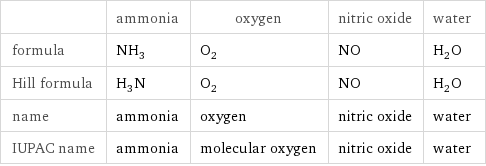
| ammonia | oxygen | nitric oxide | water formula | NH_3 | O_2 | NO | H_2O Hill formula | H_3N | O_2 | NO | H_2O name | ammonia | oxygen | nitric oxide | water IUPAC name | ammonia | molecular oxygen | nitric oxide | water